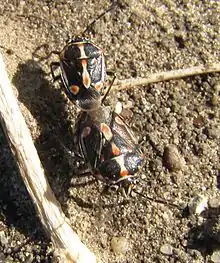Bagrada hilaris
Bagrada hilaris is a species of shield bug known by the common names bagrada bug and painted bug (See a short video at YouTube). It could be mistaken for or erroneously referred to as harlequin bug. It is native to Africa. It is known elsewhere as an introduced species, including California and Arizona, where it was first reported in 2008.[1] It is a major pest insect of Brassica oleracea crops (including cabbage, kale, cauliflower, Brussels sprouts, and broccoli), and related crucifers such as turnips, rape, and mustard.[1] The adult and nymph of the species suck sap from the leaves of the plants, causing wilting, yellowing, and stunting of growth.[2] Besides crucifers, the bugs are known on papaya, sorghum, maize, potato, cotton, caper, pearl millet, and some legumes.[1][2] Large numbers of the bug congregate on the plants and cause extensive damage.[1][2]

| Bagrada hilaris | |
|---|---|
 | |
| mating | |
| Scientific classification | |
| Kingdom: | |
| Phylum: | |
| Class: | |
| Order: | |
| Suborder: | |
| Infraorder: | |
| Superfamily: | |
| Family: | |
| Subfamily: | |
| Genus: | |
| Species: | B. hilaris |
| Binomial name | |
| Bagrada hilaris (Burmeister, 1835) | |
| Synonyms | |
|
Bagrada cruciferarum | |
The adult bug is 5 to 7 millimeters in length, shield-shaped, and black with white and orange markings. The female, which is larger than the male, lays up to 100 oval or barrel-shaped eggs on leaves or in soil beneath plants.[2] The eggs are white when freshly deposited and turn orange over time. Within 8 days the first-instar nymph emerges.[2] It is bright orange-red and turns darker as it develops, becoming black by the last instar.[2]
The bug made a sudden appearance in Los Angeles in June, 2008, its first sighting in the Western Hemisphere.[1] It then moved into the cropland of the heavily agricultural Coachella and Imperial Valleys of California, doing damage to cole crops there, especially those grown organically.[3] As of September 2014 it has reached as far north as San Mateo, Santa Cruz, Merced and Inyo counties, and all California counties to the south except Tulare County.[4]
Past infestations have been reported in India.[5] It has been recently found for the first time in Chile, South America.[6] After that by the neglected actions taken, the bug has been established and generating economic loss.[7] More recently it started to invade homes an it is considered a household pest in several Chilean localities. Also, the first case of an adventitious bite by this species has been recorded in Chile.[8]
A 2019 study found the eggs of invasive B. hilaris in Mexico being parasitized by a new species of parasitoid wasp, Idris elba (named after the actor of the same name). I. elba has thus been identified as a potential control agent for B. hilaris, which may benefit the broccoli crops that B. hilaris infests.[9]
| Wikimedia Commons has media related to Bagrada hilaris. |
References
- Center for Invasive Species Research - UC Riverside
- "Infonet-Biovision: Bagrada Bug". Archived from the original on 2013-08-16. Retrieved 2010-09-27.
- Blake, C. Bagrada bug startles cole industry. Western Farm Press November 13, 2009.
- Jeannette E. Warnert. A disheartening new pest invades California vegetable gardens - UC Riverside
- Lal, O. P. and S. Baldeo. (1993). Outbreak of the painted bug, Bagrada hilaris (Burm.) (Hemiptera: Pentatomidae) on mustard in northern India. Journal of Entomological Research 17:2.
- https://www.researchgate.net/publication/308994381_First_record_of_the_painted_bug_Bagrada_hilaris_Burmeister_1835_Heteroptera_Pentatomidae_in_South_America
- https://www.researchgate.net/publication/315497857_The_establishment_of_Bagrada_hilaris_Burmeister_1835_Heteroptera_Pentatomidae_in_Chile_an_avoidable_situation
- Eduardo I Faúndez; From Agricultural to Household Pest: The Case of the Painted Bug Bagrada hilaris (Burmeister) (Heteroptera: Pentatomidae) in Chile, Journal of Medical Entomology, , tjy091, https://doi.org/10.1093/jme/tjy091
- "Meet the new parasitic wasp species named 'Idris elba'". Mongabay Environmental News. 2019-11-21. Retrieved 2019-11-22.
External links
- Painted Bug - Photo Gallery
- Bagrada bug in California: http://ucanr.org/blogs/blogcore/postdetail.cfm?postnum=4047
- Present in Santa Barbara County: http://ucanr.org/blogs/blogcore/postdetail.cfm?postnum=8282
- Present in San Luis Obispo County: http://ucanr.org/blogs/blogcore/postdetail.cfm?postnum=8438
- California Central Coast update: http://ucanr.org/blogs/blogcore/postdetail.cfm?postnum=9531
- Host preference assays: http://ucanr.edu/blogs/blogcore/postdetail.cfm?postnum=9611
- bug bioassays: http://ucanr.edu/blogs/blogcore/postdetail.cfm?postnum=11031
- Bagrada bug biology, damage and control video:https://www.youtube.com/watch?v=gSj3AZoJIRM